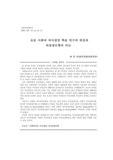

-
 * 본 문서는 배포용으로 복사 및 편집이 불가합니다.
* 본 문서는 배포용으로 복사 및 편집이 불가합니다.
미리보기
서지정보
· 발행기관 : 한국사회교과교육학회
· 수록지 정보 : 사회과교육연구 / 15권 / 1호
· 저자명 : 배진숙
목차
Ⅰ. 서론
Ⅱ. 사회과와 의사결정
Ⅲ. 사회과 의사결정 학습 연구의 변화
Ⅳ. 사회과 의사결정모형의 비교
Ⅴ. 결론
참고문헌
Abstract
초록
본 연구의 목적은 의사결정의 의미와 초등 사회과 의사결정 연구의 변천 및 사회과 의사결정
모형의 유형별 비교를 통하여 사회과 의사결정의 본질을 파악하는 데 있다.
사회과교육의 목적을 시민성 함양이라고 볼 때 시민성의 자질로서 의사결정능력을 가장 중요
하게 생각해 오고 있다. 의사결정이란 다양한 속성을 지닌 대안들 사이에서 선택을 의미하며 사
회과의 목표로서 의사결정능력 육성의 중시는 사회인식과 시민적 자질을 가장 유효하게 연결시
킬 수 있다는 점에서 의의를 갖는다.
초등 사회과에서 의사결정은 시대가 변함에 따라 연구의 초점도 약간씩 변하여 왔다. 1970년
대에 초등 사회과에서 의사결정은 사회과 역할이 변화함에 따라 사회과의 목표에서 의사결정이
중요한 부분을 차지하게 되었으며 1980년대 들어오면서 의사결정은 문제해결이나 사고의 일부분
으로 의사결정의 세부적인 과정, 기능, 모형에 관한 연구물들이 많이 등장하게 되었다. 1990년대
이르러 의사결정은 시민성 교육의 일환으로 의사결정을 강조하게 되었고 2000년대에는 의사결정
에서 충분한 토의와 토론을 거친 숙고의 과정과 학생들의 의사결정에 직접적인 참여를 강조하고
있다.
다음으로 사회과 의사결정모형을 연구자는 문제 중심적 의사결정모형, 균형적 의사결정모형,
반성적 의사결정모형으로 유형화하고 이들을 비교하여 보았다. 문제 중심적 의사결정모형을 대표
하는 Oliver & Shaver(1966)의 하버드 모형, 균형적 의사결정모형을 대표하는 Banks(1973)의 의
사결정 모형, 반성적 의사결정모형을 대표하는 Engle & Ochoa(1988)의 의사결정 모형을 검토하
여 보았다.
이러한 연구의 결과를 밑바탕으로 하여 사회과 의사결정과정, 의사결정모형에 대한 전반적인
검토가 이루어진다면 사회과 의사결정의 본질과 의사결정학습의 현장 적용에 대한 이해를 도울
수 있을 것이다.영어초록
The purpose of this study is to grasp the essence of decision-making in social studies
through the decision-making significance, a change in decision-making research of
elementary social studies, and the comparison by type in decision-making models.
Given seeing that the objective of social studies is to promote citizenship, the
decision-making ability as the quality of citizenship has been thought to be most
importantly. Decision-making implies an option among alternative plans, which have
diverse properties. And, the emphasis on fostering decision-making ability as the goal of
social studies has a significance in a sense that can connect the social awareness and the
citizenship most effectively.
The decision-making in elementary social studies has been changed little by little even a
focus of research as the period is changed. Regarding the decision-making of elementary
social studies in the 1970s, as a role of social studies is changed, the decision-making in
the objective of social studies came to possess the important portion. And, entering the
1980s, as the decision-making is one part of solution or a thought, the research materials
on the detailed process, function and model in decision-making came to appear much.
Entering the 1990s, the decision-making came to stress the decision-making as part of
educating citizenship. And, in the 2000s, it is being emphasized the process of deliberation,
which passed through enough discussion and debate in the decision-making, and students'
direct participation in decision-making.
Next, the researcher allowed the decision-making model in social studies to be types in
problem-centered decision-making model, balanced decision-making model, and reflective
decision-making model, and then tried to compare these things. It tried to examine
Harvard model by Oliver & Shaver(1966) who stands for the problem-centered
decision-making model, the decision-making model by Banks(1973) who stands for the
balanced decision-making model, and the decision-making model by Engle & Ochoa(1988)
who stands for the reflective decision-making model.
When the whole examination is performed on the decision-making process and the
decision-making model in social studies based on these findings, the understanding may
be helped about the essence of decision-making in social studies and about application of
the decision-making learning to the field.참고자료
· 없음태그
-
자료후기
-
자주묻는질문의 답변을 확인해 주세요

꼭 알아주세요
-
본 학술논문은 (주)학지사와 각 학회간에 저작권계약이 체결된 것으로 AgentSoft가 제공 하고 있습니다.
본 저작물을 불법적으로 이용시는 법적인 제재가 가해질 수 있습니다. -
해피캠퍼스는 구매자와 판매자 모두가 만족하는 서비스가 되도록 노력하고 있으며, 아래의 4가지 자료환불 조건을 꼭 확인해주시기 바랍니다.
파일오류 중복자료 저작권 없음 설명과 실제 내용 불일치 파일의 다운로드가 제대로 되지 않거나 파일형식에 맞는 프로그램으로 정상 작동하지 않는 경우 다른 자료와 70% 이상 내용이 일치하는 경우 (중복임을 확인할 수 있는 근거 필요함) 인터넷의 다른 사이트, 연구기관, 학교, 서적 등의 자료를 도용한 경우 자료의 설명과 실제 자료의 내용이 일치하지 않는 경우
“사회과교육연구”의 다른 논문도 확인해 보세요!
-
초등 교사의 역사적 관점 함양을 위한 연수프로그램의 개발 26 페이지
역사교육은 사회과의 시민성의 함양에 중요한 영역이라고 할 수 있으며, 역사학습의 목표, 내용 및 방법은 시민성의 형성에 관련된다는 것을 확인하였다. 다음으로 역사적 관점과 관련된 초등 교사의 전문성의 영역에는 역사 내용 그 자체에 대한 이해와 함께 역사 내용을 학습자에 게 전달하는 방식이 포함된다. 역사 내용에는 한국사와 세계사의 구체적인 내용 보다는.. -
초등 6학년「사회」교과서의 어휘 분석과 교수.학습자료와의 관련성 탐색 25 페이지
초등학교 교실수업의 교수ㆍ학습에서 「사회」교과서가 차지하는 비중이 절대적이라고 한다면 이들 교과서를 창조적으로 활용하는 방안을 모색해 보는 것이 교실수업의 교수ㆍ학습을 개선해 보려는 노력에서 현실적인 대안이 될 수 있을 것이다. 그 중 하나는 교과서의 내용을 중심으로 다른 교수ㆍ학습자료들을 배치하는 것이고, 다른 하나는 교과서의 내용을 토대로 재구성하는 .. -
사회과 체험학습의 의미 탐색 25 페이지
학교교육은 학습자 중심 교육의 패러다임으로 진행되고 있다. 그 정점에 있는 교육 철학이 자기주도적 학습, 열린교육, 체험학습이라 할 수 있다. 체험은 1인칭적 주관적 경험으로 인식되 며 인간의 내면을 대상으로 하기 때문에 생생함과 강렬함을 가지며 삶과 관련된 개별적인 또 는 개성적인 경험에 한정해서 사용한다. 체험학습은 체험-표현-이해라는 순환적 과정.. -
사회과 인권교육 내용요소의 통합적인 구성 방안 24 페이지
본 연구의 목적은 사회과에서 나타난 인권교육의 문제점을 분석하고, 이에 대한 대안적인 인권교육의 방안을 모색하는 지호에 있다. 이를 위해 먼저 사회과에서 인권과 인권교육의 개념 을 분석하였다. 그리고 그동안 사회과에서 진행된 인권교육에 대한 선행연구 분석을 통해서 사 회과에서 인권교육의 문제점을 분석하였다. 그 결과, 사회과의 인권교육에서 나타난 문제.. -
사회과 교육 기반으로서의 일상성 비판 : 들뢰즈의 시각을 중심으로 19 페이지
본 연구는 사회과교육의 기반이 일상성임을 주장하는 것이다. 그 이유는 사회과교육이 역사와 전통, 사회과학의 지식과 연구 방법을 비로소 실현되는 장으로 일상성에 귀결될 수 밖에 없기 때 문이다. 그러나 그 동안의 일상성은 투사(投射)의 모습으로 비춰지거나 공공영역과 대별 되거나 개별 주체가 뜻대로 조절할 수 있는 고유성으로 이해한 문제가 있다. 들뢰즈..
문서 초안을 생성해주는 EasyAI


